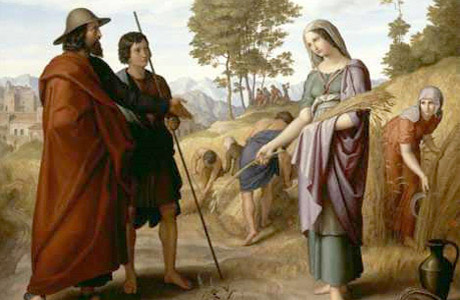MAY 19TH AND 20TH…..THE MEANING OF SHAVUOT….THE BOOK OF RUTH
The rest is happy history…and here’s the story thanks to my friend Ricky Greenfield the publisher of the Connecticut Jewish Ledger….and our wedding picture….rsk…..Â
 “Ruth in Boaz’s Field†by Julius Schnorr von Carolsfeld, 1828.Book of Ruth
“Ruth in Boaz’s Field†by Julius Schnorr von Carolsfeld, 1828.Book of Ruth
The biblical book of Ruth, read later this week on the holiday of Shavuot, works in brief, gentle strokes to limn a powerful story of loss, recovery, and redemption. The story takes place in harvest season, in a prosaic world in which the actions of divine providence are coterminous with the yield of human goodness. “This scroll speaks neither of impurity nor purity, neither of forbidden nor permitted,” says a famous midrash. “And why was it written? To teach you how great is the reward of those who mete out lovingkindness” (Midrash Ruth Rabbah 2:16).
 The theme asserts itself in the book’s opening. A truncated family of three widows, an older woman and her two daughters-in-law, has traveled from Moab to the outskirts of Bethlehem. Naomi, the older woman, urges the younger ones, Orpah and Ruth, to turn back and start their own lives. Orpah goes, but Ruth delivers a stunning declaration: “Do not urge me to leave you, to turn back and not follow you. For wherever you go, I will follow; wherever you live, I will live; your people will be my people and your God my God. Where you die I will die, and there will I be buried” (1:16–17).
 This speech of Ruth’s has become the fundamental template of conversion to Judaism: the act of casting one’s lot with the community of Israel in its bodily existence and its spiritual journeys, in life and death. Whenever the book was written—scholarly opinions differ—its depiction of King David’s great-grandmother as a daughter of Moab, one of ancient Israel’s bitterest enemies, is breathtaking. As the contemporary interpreter Avivah Zornberg points out, these simple, daring words, uttered by a young woman who boldly proceeds to act on them, shatter what until then had been an impermeable barrier of Israelite law, thus reshaping the law and Jewish history at once.
 As for Orpah, the daughter-in-law who turned away, Jewish tradition was unforgiving, portraying her as a harlot and worse, and as the mother of none other than Goliath. In 1934, the poet Chaim Nachman Bialik, watching the world scene darken, gathered together a group of Orpah legends in a brief, savage text, “The Scroll of Orpah,” asserting an eternal divide between virtuous and evil Gentiles. In recent years, some feminist interpreters have attempted to find a place for this seemingly wayward daughter.
 And why is Ruth read on Shavuot? The 13th-century Sefer Hamanhig, a treasury of law and custom, offers two reasons. Shavuot is, after all, a celebration of the spring harvest, when the story is set. But Shavuot also commemorates the giving of the Torah on Mount Sinai. Just as Ruth was a convert, so were all the Israelites present at that event: “indeed, Israel underwent conversion on receiving the Torah.” And that experience of conversion, like the receipt of the Torah itself, was not a one-time event. Each generation and each individual must renew the covenant with Jewish fate and destiny—the same covenant clasped by the young Moabite woman who entered and regenerated the community through sheer goodness and courage.
Comments are closed.
